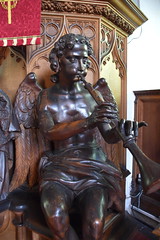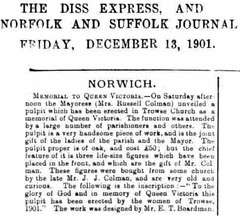| |
|
St
Andrew, Trowse, Norwich Is
Trowse really in Norwich? It feels as if it is, sitting
as it does just off the outer ring road, and overshadowed
by the tower block of County Hall and the vast former
Colmans Mustard works. But when I first came here about
ten years ago I suggested to the old boy who came to open
up that this was the last medieval church in Norwich left
for me to visit. He gave me a wry look. He'd lived here
for years and years, and he didn't think Trowse was in
Norwich. "Norwich? Where's that?" he said.
St Andrew still has three keyholders and a welcoming
notice. That said, it had an unwelcome visitor one night
in the 1980s when a vehicle spun out of control at the
exit from the lane to Whittingham, and almost crashed
into the east end of the church. He would have destroyed
what is one of the most interesting features of the
church, the east window tracery and the inscription
beneath it which records that Wilelmus de Kirkebei
Prior Norvic me posuit, 'William of Kirkby, Prior of
Norwich, placed me here'. Kirkby was Prior from 1272 to
1289, and so the window in question is right at the start
of the Decorated style. Pevsner compared it with the
great east window at Lincoln Cathedral, which can be
confidently dated to 1275.
The city of Norwich may be ignored here perhaps, but the
Colmans may not, for although they were non-conformists,
this church was in the family's patronage. Their
influence here is felt two-fold. Firstly, they paid for a
late, major restoration in 1901, after the church had
been severely damaged by flooding. The nave was
substantially rebuilt at this time. Secondly, the
interior benefits from some of their somewhat
idiosyncratic art collection. The major feature is the
vast altarpiece originally in St Michael Coslany. This is
enormous, perhaps ten feet high, and is now set on the
south wall of the nave. It dates from the first decades
of the 18th Century, and was the work of the Norwich
artist Charles Heins. It may well have once sat at the
east end here, for the four figures which originally
flanked it are still in situ either side of the east
window.
However, the most memorable feature is the set of three
18th Century life-size figures, two angels and a king,
who sit playing instruments on the front of the pulpit.
They must have come from a Dutch or Flemish organ case,
and were collected by the Colman family, probably in the
early 19th Century. The piece was installed in the church
as a memorial to Queen Victoria, as the cutting below
from the Diss Express, collected by Pete Bardwell,
explains.
 
  
Appearing to match them, but
probably local work, is the dramatic 18th Century pelican
in her piety forming the lectern across the nave. It was
probably only formed into a lectern at the time of the
1901 restoration, which also brought the reredos, again
the work of a local carver, which presents the Last
Supper in neo-realistic three dimensional detail, and the
unexceptional glass above.
Amongst these exotic attractions, something from the much
more distant past sits waiting patiently. This is one of
the city's best 15th Century fonts, sadly defaced but
replete with detail. Lions alternate with angels holding
shields, while around the base clerical figures sit among
the evangelistic symbols. Finally, don't miss the
parish's World War Two memorial, the surprisingly few
names suggesting that this parish is, in fact, a rural
one after all. They are engraved on a light-hearted
medallion in the 17th Century style, so convincing that
unless you took a moment to read it you might think it
really was that old.
Simon Knott, August 2019
Follow these journeys as they happen at Last Of England
Twitter.
|
|
|
